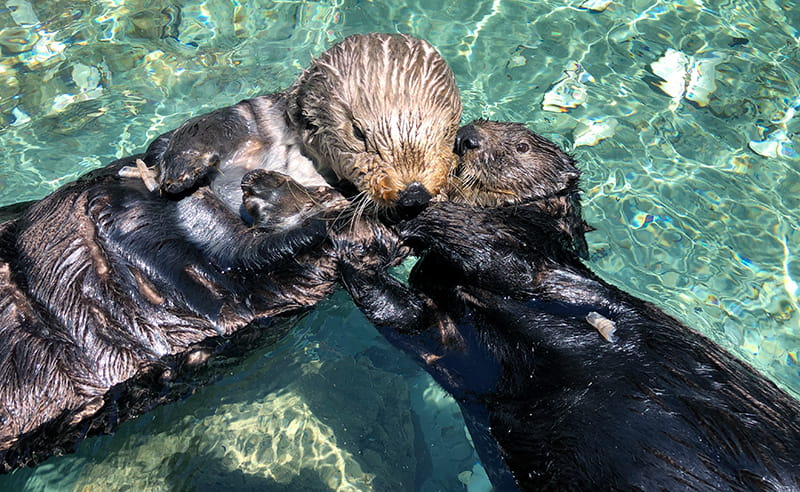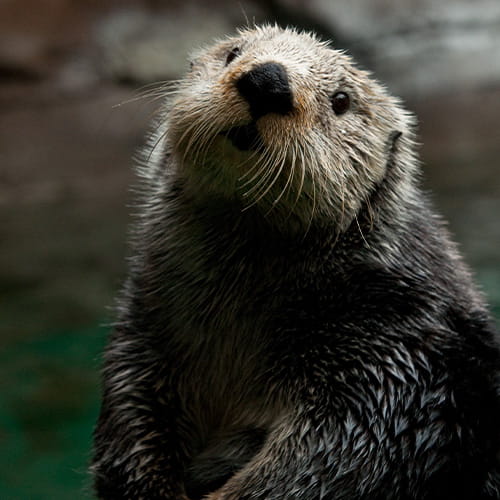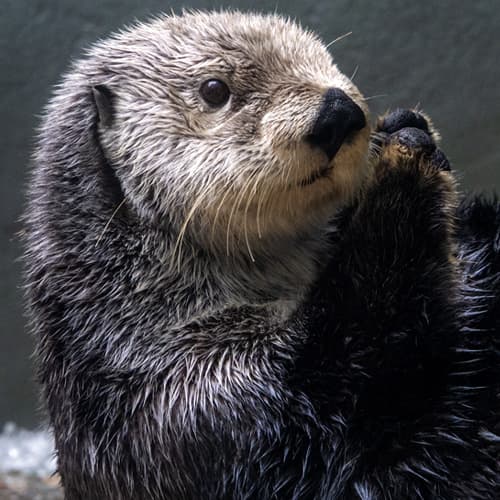Explore the Ocean Pavilion
For more than 10,000 years, the Coast Salish people have stewarded the lands and waters of the Pacific Northwest. They continue to do so today. The Seattle Aquarium honors our location in this revered space and our ongoing collaboration with Coast Salish peoples and the urban Indigenous community as we reimagine our role as a 21st-century aquarium.
COAST SALISH ART: AN INCLUSIVE WELCOME TO THE OCEAN PAVILION
Co-creation with the Indigenous community — bringing together diverse perspectives and knowledge to develop thoughtful approaches — has guided the Aquarium’s Ocean Pavilion project for years.
The team of Aquarium and Indigenous designers recognized that the experience of stepping into the Ocean Pavilion would need to be warm and welcoming for all while acknowledging the Aquarium’s site on Coast Salish lands. The building’s public art component offered an opportunity to meet both goals.
To lead the selection of a Coast Salish artist who could integrate tribal art into the Ocean Pavilion’s design, the Aquarium engaged art consultant Asia Tail (Cherokee Nation of Oklahoma and member of the urban Native community).
Through the process, an all-Indigenous committee chose local glass artist Daniel Joseph Friday (Lummi) to create a dynamic installation of glass salmon for the Ocean Pavilion’s main entry. Dan — who was recently featured on the Netflix series Blown Away — combines layers of mediums including storytelling, Coast Salish art design and blown glass to create work that draws people in and inspires them.
Dan says, “[It’s] the history of the land, but this is going to be an Aquarium for everybody: the Eritrean kids, the Sumatran kids, the kids from all over the world.”
See Dan’s vision for his Ocean Pavilion installation:
Paddle-carving artists in action
Paddles symbolize the universal connection between people and the ocean. The Aquarium, guided by Owen Oliver (Quinault and Isleta Pueblo) of Headwater People Consulting, has opened conversations with Indigenous paddle-carvers in the Pacific Northwest, in Indonesia and with the Burke Museum to participate in the Ocean Pavilion’s exhibit program. These paddles will be on display in the Ocean Pavilion.
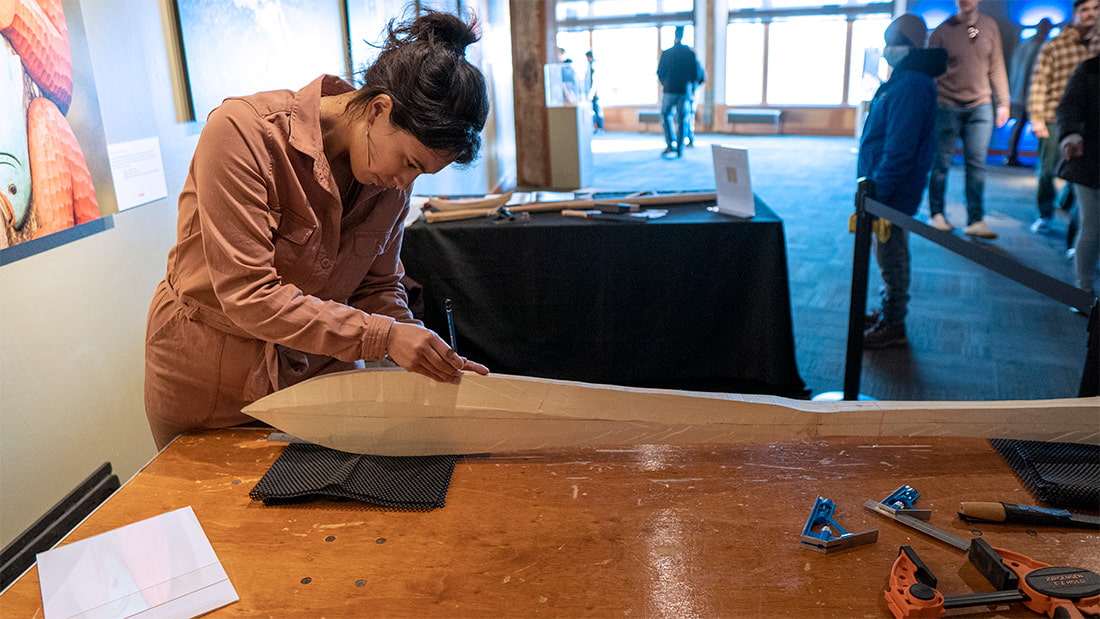
Inside the Ocean Pavilion, you’ll also be able to view a seasonal migration wheel of the Salish Sea created by visual artist Paige Pettibon (Confederated Salish and Kootenai). This piece tells the cyclical story of seasons, lunar cycles and species from the land, air and ocean.
UP ON THE ROOF: A JOURNEY THROUGH ECOSYSTEMS FROM TAHOMA TO THE SALISH SEA
Guided by food sovereignty and traditional ecological knowledge keeper Valerie Segrest (Muckleshoot) — co-founder and principal at Tahoma Peak Solutions — the Ocean Pavilion’s rooftop ecosystem design plan began with the concept of whitecap to whitecap — a journey from the top of Tahoma (Mount Rainier) to the shores of the Salish Sea.
As you traverse the Ocean Pavilion’s rooftop, you’ll progress through representations of ecosystems that mirror our local coastline and the diverse plant species that inhabit several of those ecosystem communities. This journey honors the relationships Coast Salish people carry with plants from this region. The project connects with Valerie’s horticultural design work along the nearby Overlook Walk.
“For thousands of years Coast Salish Ancestors have maintained food forests, camas prairies, berry meadows and patches and shellfish gardens,” Valerie says. “Without their intervention, these ecosystems wouldn’t exist in the way they do to this day.”
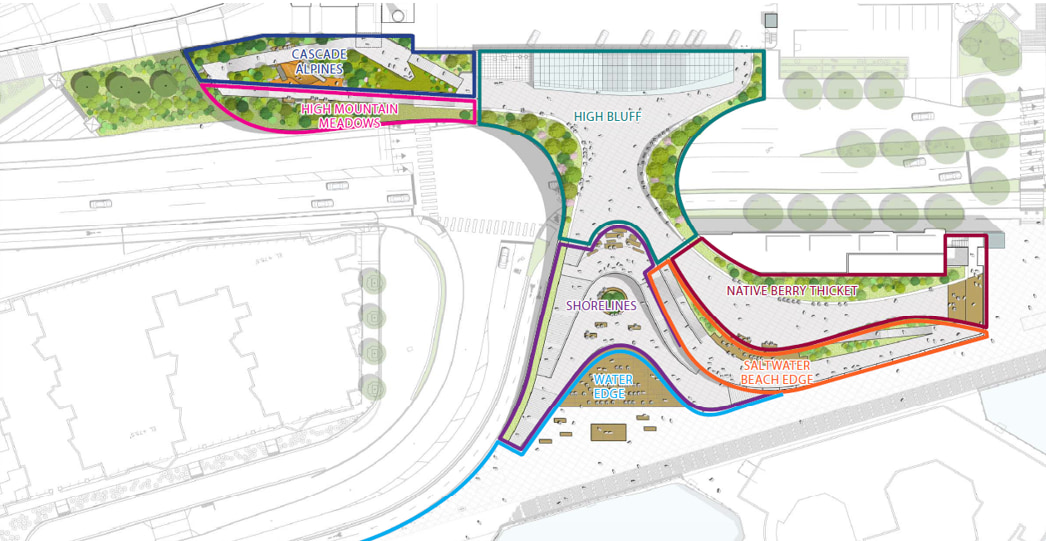
Sandblasted images on the rooftop will complement the plantings’ story. The sandblasting project, led by Owen Oliver — working in concert with other Indigenous consultants and the Aquarium’s design and architectural team — will depict the city’s original tidal flats and the time-honored process of gathering food from the shoreline to feed communities. You’ll be able to view representations of shellfish, seaweeds and baskets designed for food-gathering and, on the rooftop’s southern-most end, a textured design of Tahoma. “We’re showing that this gathering process isn’t an extractive method, but one that is steeped in care, responsibility and reciprocity,” Owen says.

INDIGENOUS KNOWLEDGE SHAPES DESIGN OF THE OCEAN PAVILION
Early in the Ocean Pavilion’s development, we partnered with Headwater People Consulting founder Colleen Echohawk (Pawnee and Upper Athabascan) to establish cross-cultural collaboration between local Coast Salish and urban Indigenous leaders and the Aquarium’s design and architectural team.
We have intentionally and purposefully invited an Indigenous design team to partner with the architects and exhibit designers of the Ocean Pavilion. We know that the fields of architecture and design have not traditionally been career paths that Native people have had equal and equitable access to; it was a matter of equity for us to find other ways for Native people to be leaders and designers in this project. All participants have had to practice cultural humility and be open to new ways to understand planning design, science and conservation.
Pivotal to the Ocean Pavilion’s development, Coast Salish voices — from elders’ wisdom and traditional stories to the influence of tribal cultural centers, a tribal-youth design workshop and listening sessions with Aquarium’s architects and exhibit designers — generated ideas for the building’s features, including its art and unique rooftop design. Indigenous community input on interpretative programming will extend beyond the building’s opening.
With the Aquarium’s new focus on the Coral Triangle, we’ve opened cross-cultural conversations in Indonesia, too. In 2019, Aquarium representatives and key Ocean Pavilion consultant Robin Little Wing Sigo (Suquamish) — director of research and strategic development for the Suquamish Tribe — traveled to Bali with us for just this purpose. “I was able to meet other Indigenous people who are doing the work that my tribe and I are doing,” Robin says. “We’re using ancestral knowledge and modern-day technology to create something that’s going to last for generations and generations beyond us.”
